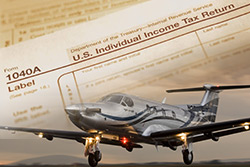 Uncle Sam may be good to you this year! If you recently purchased an airplane that you are using primarily for business—more than 50% of its use is for business—or thinking about improving the business aircraft you own with upgraded equipments or avionics, you’ll be interested to learn about recent changes to the tax law regarding bonus depreciation and Section 179 expensing. AOPA consulted with our tax expert, Raymond C. Speciale, Esq., CPA, who is the author of AOPA’s publication, The Pilot’s Guide to Taxes . He reviewed the tax guide and added some new information. Here are the highlights.
Uncle Sam may be good to you this year! If you recently purchased an airplane that you are using primarily for business—more than 50% of its use is for business—or thinking about improving the business aircraft you own with upgraded equipments or avionics, you’ll be interested to learn about recent changes to the tax law regarding bonus depreciation and Section 179 expensing. AOPA consulted with our tax expert, Raymond C. Speciale, Esq., CPA, who is the author of AOPA’s publication, The Pilot’s Guide to Taxes . He reviewed the tax guide and added some new information. Here are the highlights.
Bonus Depreciation
According to Speciale, increased bonus depreciation is available for new business-use aircraft and equipment purchases. The “Tax Relief, Unemployment Insurance Reauthorization, and Job Creation Act of 2010,” signed by President Barack Obama on December 17, 2010, extended and expanded first-year depreciation to 100 percent of the cost of new aircraft purchases and new equipment purchases when they are placed in service after September 8, 2010 and before December 31, 2011.
On January 1, 2012, the bonus depreciation returns to 50 percent until December 31, 2012 when it expires. In order for new aircraft and equipment to qualify for bonus depreciation they must be original or first-use aircraft (or equipment), used primarily for business purposes, and must also meet existing tests necessary to qualify for accelerated depreciation under MACRS (modified accelerated cost recovery system).
If your aircraft use is not predominantly business, the aircraft will be depreciable only under the straight line method mandated by what is called the ADS (alternate depreciation system) and is not eligible for bonus depreciation.
"Section 179" deductions
Section 179 is an Internal Revenue Code provision that allows for an election to deduct or expense the cost of an aircraft. The law signed by President Obama in December allows a new or used aircraft purchased for business use to take an immediate deduction of up to 100% of the first $500,000 of the aircraft price for 2010 and 2011.
Speciale explains, “This election is subject to a number of limitations, including a dollar-for-dollar reduction for an aircraft placed in service which costs in excess of $2,000,000 for 2010 and 2011 (which means the maximum investment in a new or used aircraft would need to be less than $2,500,000 to be eligible for a Section 179 deduction). For 2012, the new law permits the expensing of up to $125,000. The $125,000 is reduced by the amount the cost of your aircraft exceeds $500,000 (which means the maximum investment in a new or used aircraft would need to be less than $625,000 to be eligible for a Section 179 deduction). Importantly, the amount of any Section 179 deduction is further limited by the amount of taxable income from your aviation-related activity.”
For more details, read, The Pilot’s Guide to Taxes . It answers questions, such as, “How does depreciation affect my taxable income when I sell my airplane?” and “Over how many years will my aircraft be depreciated using current depreciation methods?”
Remember, AOPA offers this information as just that—information—not tax advice! Please consult with your professional tax advisor for guidance on your individual situation. If your tax professional is not familiar with aviation, we can help you find one who is. Give us a call at 800-USA-AOPA, Monday through Friday, 8:30 a.m. to 6:00 p.m. Eastern Time.



